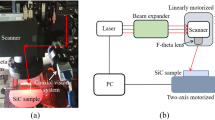Abstract
Silicon carbide (SiC) is well known as an excellent material for high performance optical applications because it offers many advantages over other commonly used glasses and metals. The excellent attributes of SiC include high strength, high hardness, low density, high thermal resistance, and low coefficient of thermal expansion. The effect of CO2 laser and its tool path on SiCwere investigated. The process started by creating laser pre-cracks on the desired pattern. Subsequently, laser assisted polishing was conducted on the same tool path. The surface showed a sharp increase in material removal in the areas with laser pre-cracks. This high difference in material removal was used not only to fabricate a ⌀ 1100 mm concave mirror with 127 μm in depth but also to generate macro and micro patterns. Grooves from 2 mm to 200 μm in width and 5 μm to 20 μm depth were successfully generated.













Similar content being viewed by others
References
Johnson, J. S., Grobsky, K. D., & Bray, D. (2002, September). Rapid fabrication of lightweight silicon-carbide mirrors. In Proceedings on optomechanical design and engineering 2002.
Sun, S., Brandt, M., & Dargusch, M. S. (2010). Thermally enhanced machining of hard-to-machine materials: A review. International Journal of Machine Tools and Manufacture,50(8), 663–680.
Suzuki, H., Kodera, S., Nakasuji, T., Ohta, T., & Syoji, K. (1998). Precision grinding of aspherical CVD-SiC molding die. International Journal of the Japan Society for Precision Engineering,32(1), 25–30.
Evans, C. J., Paul, E., Dornfeld, D., Lucca, D. A., Byrne, G., Tricard, M., et al. (2003). Material removal mechanisms in lapping and polishing. Annals ofthe CIRP,52(2), 611–633.
Kim, D.-H., & Lee, C.-M. (2016). A study on the laser-assisted ball-end milling of difficult-to-cut materials using a new back-and-forth preheating method. International Journal of Advanced Manufacturing Technology,85(5–8), 1825–1834.
Klocke, F., & Zunke, R. (2009). Removal mechanisms in polishing of silicon based advanced ceramics. CIRP Annals - Manufacturing Technology,58(1), 491–494.
Wegener, K., Bleicher, F., Krajnik, P., Hoffmeister, H. W., & Brecher, C. (2017). Recent developments in grinding machines. CIRP Annals - Manufacturing Technology,66(2), 779–802.
Chen, B., Li, S., Deng, Z., Guo, B., & Zhao, Q. (2017). Grinding marks on ultra-precision grinding spherical and aspheric surfaces. International Journal of Precision Engineering and Manufacturing-Green Technology,4(4), 419–429.
Xing, Y. Q., Deng, J. X., Zhang, K. D., & Gao, H. H. (2014). Effect of femtosecond laser pretreatment on wear resistance of Al2O3/TiC ceramic tools in dry cutting. International Journal of Refractory Metals and Hard Materials.,43, 291–301.
Zum Gahr, K. H. (1989). Sliding wear of ceramic-ceramic, ceramic-steel and steel-steel pairs in lubricated and unlubricated contact. Wear,133, 1–22.
Tsumori, F., et al. (2016). Wavy micro channels in micropatterned ceramic sheet formed by combined process of laser beam machining and imprinting. Journal of the Japan Society of Powder and Powder Metallurgy,63(7), 511–518.
Dandekar, C. R., Shin, Y. C., & Barnes, J. (2010). Machinability improvement of titanium alloy (Ti–6Al–4V) via LAM and hybrid machining. International Journal of Machine Tools and Manufacture,50(2), 174–182.
Lauwers, B., Klocke, F., Klink, A., Tekkaya, A. E., Neugebauer, R., & Mcintosh, D. (2014). Hybrid processes in manufacturing. CIRP Annals - Manufacturing Technology,63(2), 561–583.
Chu, W. S., Kim, M. S., Jang, K. H., Song, J. H., Rodrigue, H., Chun, D. M., et al. (2016). From design for manufacturing(DFM) to manufacturing for design(MFD) via hybrid manufacturing and smart factory: a review and perspective of paradigm shift. International Journal of Precision Engineering and Manufacturing-Green Technology,3(2), 209–222.
Chu, W. S., Kim, C. S., Lee, H. T., Choi, J. O., Park, J. I., Song, J. H., et al. (2014). Hybrid manufacturing in micro/nano scale: A Review. International Journal of Precision Engineering and Manufacturing-Green Technology,1(1), 75–92.
Jeon, Y., Park, H. W., & Lee, C. M. (2013). Current research trends in external energy assisted machining. International Journal of Precision Engineering and Manufacturing,14(2), 337–342.
Kurniawan, R., Ali, S., Park, K. M., Li, C. P., & Ko, T. J. (2019). Development of a three-dimensional ultrasonic elliptical vibration transducer (3D-UEVT) based on sandwiched piezoelectric actuator for micro-grooving. International Journal of Precision Engineering and Manufacturing,20(7), 1229–1240.
Liang, Y., Chen, Y., Chen, B., Fan, B., Yan, C., & Fu, Y. (2019). Feasibility of ultrasonic vibration assisted grinding for carbon fiber reinforced polymer with monolayer brazed grinding tools. International Journal of Precision Engineering and Manufacturing,20, 1083–1094.
Cha, N. H., & Lee, C. M. (2015). A study on machining characteristics of silicon nitride with spline members in laser-assisted turn-mill. International Journal of Precision Engineering and Manufacturing,16(13), 2691–2697.
Lee, C. M., Kim, D. H., Baek, J. T., & Kim, E. J. (2016). Laser assisted milling device: A review. International Journal of Precision Engineering and Manufacturing-Green Technology,3(2), 199–208.
Wang, C., Kurokawa, S., Doi, T., Yuan, J., Sano, Y., Aida, H., et al. (2017). The polishing effect of SiC substrates in femtosecond laser irradiation assisted chemical mechanical polishing (CMP). ECS Journal of Solid State Science and Technology,6(4), P105–P112.
Kim, M., Bang, S. M., Kim D. H., Lee, H.T., Kim, G. H. and Ahn, S.H. (2019) Hybrid CO2 Laser Polishing Process For Machining Silicon Carbide. The International Journal of Advanced Manufacturing Technology. https://doi.org/10.1007/s00170-019-04846-0
Acknowledgements
This work was supported by Korea Basic Science Institute (KBSI) Creative Convergence Research Project (CAP-15-01-KBSI) funded by the National Research Council of Science and Technology (NST) and the Basic Research Lab Program through the National Research Foundation of Korea (NRF) funded by the MSIT(2018R1A4A1059976).
Author information
Authors and Affiliations
Corresponding author
Additional information
Publisher's Note
Springer Nature remains neutral with regard to jurisdictional claims in published maps and institutional affiliations.
Rights and permissions
About this article
Cite this article
Abrego Serrano, P.A., Kim, M., Kim, DR. et al. Spherical Mirror and Surface Patterning on Silicon Carbide (SiC) by Material Removal Rate Enhancement Using CO2 Laser Assisted Polishing. Int. J. Precis. Eng. Manuf. 21, 775–785 (2020). https://doi.org/10.1007/s12541-019-00304-9
Received:
Revised:
Accepted:
Published:
Issue Date:
DOI: https://doi.org/10.1007/s12541-019-00304-9




